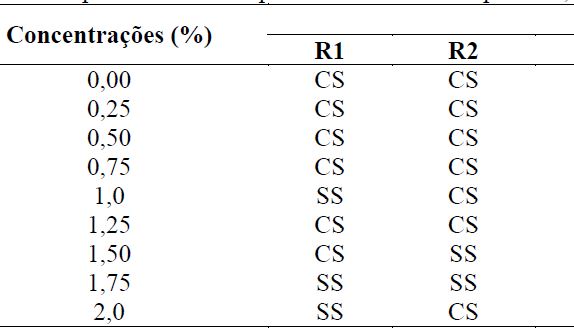Avaliação do efeito curativo e preventivo do óleo essencial do capim citronela no controle de Pyricularia grisea
DOI:
https://doi.org/10.20873/jbb.uft.cemaf.v2n2.periniKeywords:
Cymbopogon nardus, medicinal plants, fungitoxicityAbstract
The rice blast is the most important disease of the rice, due to the damage that it causes in the productivity andgrain quality. Aiming at the use of essential oils and plant extracts to control this disease. The objective of this study was to evaluate the curative and preventive effect of the extracts and essential oil of citronella grass (Cymbopogon nardus L.) to control rice blast. The evaluation of the curative effect was performed seven days after the sprayingwith the extracts of citronella grass. As for the evaluation of preventive effect, the plants were sprayed with thetreatments and 24 hours after inoculated with 20 mL of the spore solution per tray. In the assessing of the curative effect, it was found that the application of fungicide and the diluted essential oil of citronella grass at a concentration of 2% plants showed no symptoms of blast in 50% of the repetitions. Regarding the evaluation of preventive effect, the plants showed no symptoms of the disease in concentrations of 1.5, 1.75 and 2% of the essential oil of citronella grass in 50% of the repetitions.
References
BILLERBECK, V. G.; ROQUES C.G.; BESSIÈRE, J.M.; FONVIEILLE, J.L.; DARGENT, R. (2001), Effects of Cymbopogon nardus(L.) W. Watson essential oil on the growth and morphogenesis of Aspergillus niger. Canadian Journal of Microbiology. 47, 9-17.
DIAS NETO, J. J.; SANTOS, G. R.; ANJOS, L. M.; RANGEL, P.H.N. (2010), Hot spots for diversity ofMagnaporthe oryzaephysiological races in irrigated rice fields in Brazil. Pesquisa Agropecuária Brasileira, 45, 252-260.
DINIZ, S. P. S. S.; COELHO, J. S.; ROSA, G. S.; SPECIAN, V.; OLIVEIRA, R. C.; OLIVEIRA, R. R. (2008), Bioatividade do óleo essencial de Mentha arvensisL. no controle de fungos fitopatógenos..Revista Brasileira de Plantas Medicinais, 10,9-11.
FRANZENER, G.; MARTINEZ-FRANZENER, A. S.; STANGARLIN, J. R.; CZEPAK, M. P.; SCHWAN-ESTRADA, K. R. F.; CRUZ, M. E. S. (2007). Atividades antibacteriana, antifúngica e indutora de fitoalexinas de hidrolatos de plantas medicinais. Semina: Ciências Agrárias, 28, 29-38.
LAVABRE, M. (1993), Aromaterapia: a cura pelos óleos essenciais. 5ª Ed. Rio de Janeiro: Nova Era. 172p.Lima, W. G. Controle alternativo da ramulose do algodoeiro via utilização de óleos essenciais. Dissertação (Mestrado) -Universidade Federal Rural de Pernambuco, 2007.
MARQUES, R. P.; MONTEIRO, A.C.; PEREIRA, G.T. (2004), Crescimento, esporulação e viabilidade de fungos entomopatogenicos em meios contendo diferentes concentrações do óleo de nim (Azadirachta indica). Ciência Rural, 34,1675-1680.
MEDICE, R.; ALVES, E.; ASSIS, R.T.; MAGNO JÚNIOR, R.G.; LOPES, E.A.G.L. (2007), Óleos essenciais no controle da ferrugem asiática da soja Phakopsora pachyrhiziSyd. & P. Syd.Ciência Agrotécnica.31, 83-90.
SANTOS, G. R.; KORNDORFFER, G.; REISILHO, J. C. D.; PELÚZIO, J. M. (2003), Adubação com silício: influência sobre as principais doenças e sobrerodutividade de arroz irrigado por inundação. Revista Ceres, 50, 1-8.
SANTOS, G. R.; RANGEL, P. H. N.; SANTIAGO, C. M.; LEÃO, F. F.; MARRA, B.; ALMEIDA J. D. (2005), Reação a doenças e caracteres agronômicos de genótipos de arroz de várzeas no Estado doTocantins. Revista Agropecuária Técnica, 26, 51 -57.
TRONGTOKIT, Y.; RONGSRIVAM, Y.; KOMALAMISRA, N.; APIWATHNASOM, C. (2005), Comparative repellency of 38 essential oils against mosquito bites. Phytotherapy Research,19,303-309.
WILSON, C. L.;SOLAR, J. M.; EL GHAOUTH, A.; WISNIEWSKI,M. E. (1997), Rapid evaluation of plant extracts and essential oils for antifungal activity against Botrytis cinerea. Plant Disease, 81, 204-210.
WONG, K.K; SIGNAL, F.A.; CAMPION, S.H.; MOTION, R.L. (2005), Citronella as an insect repellent in food packaging. Journal of Agricultural and Food Chemistry, 53, 4633-4636.

Published
How to Cite
Issue
Section
License
Copyright (c) 2024 - Journal of Biotechnology and Biodiversity

This work is licensed under a Creative Commons Attribution 4.0 International License.
Authors who publish with this journal agree to the following terms:
Authors retain copyright and grant the journal right of first publication with the work simultaneously licensed under a Creative Commons Attribution License (CC BY 4.0 at http://creativecommons.org/licenses/by/4.0/) that allows others to share the work with an acknowledgement of the work's authorship and initial publication in this journal.
Authors are able to enter into separate, additional contractual arrangements for the non-exclusive distribution of the journal's published version of the work (e.g., post it to an institutional repository or publish it in a book), with an acknowledgement of its initial publication in this journal.
Authors are permitted and encouraged to post their work online (e.g. in institutional repositories or on their website) prior to and during the submission process, as it can lead to productive exchanges, as well as earlier and greater citation of published work (Available at The Effect of Open Access, at http://opcit.eprints.org/oacitation-biblio.html).


